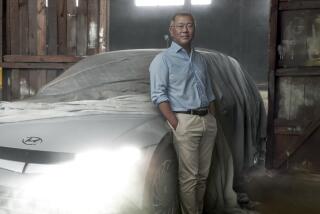Engine of Success : Subaru Is Back With a Popular Line of Hybrid Cars
DETROIT â Just three years ago, Subaru of America--the sometimes-quirky auto company that once prospered by catering to suburban and rural drivers in the Snowbelt--lay in a shambles.
Crippled by the rising yen and strategic mistakes, Subaru sales had fallen for seven years. The company lost $750 million in the same period and was considered likely to withdraw from the U.S. market.
But this year, Subaru, owned by Japanâs Fuji Heavy Industries, appears finally to have matched a car with a market--a newly emerging demand for a cross between a car and a Jeep-like vehicle--and sales have jumped 26%.
If Subaru has turned the corner, it may actually be headed back to the future.
After losing its way by trying to be all things to all people, analysts say, the company refocused its energies on what it does best--making and selling all-wheel-drive passenger cars that offer utility, durability and safety.
By doing so, Subaru grabbed a lead in whatâs being called the hybrid sport-utility vehicle market. Hybrids--the fastest-growing corner of the huge market for sport-utility vehicles--combine the ride, handling, comfort and fuel economy of a car with the utility, ruggedness and off-road capability of a truck.
Subaru claims that all-wheel-drive provides superior handling and traction compared with other vehicles, including four-wheel-drive trucks. All-wheel-drive operates automatically, spinning each tire independently and at the proper speed, to provide better traction in corners and on slippery surfaces. Four-wheel-drive must be engaged by the driver.
Subaruâs pioneering work in the hybrid sport-utility market has not gone unnoticed. Nearly every major auto maker is now working on passenger-car-based sport-utilities. Some are already entering the market, such as Toyotaâs car-based RAV4 and Hondaâs Civic-based CR-V.
âEverybody is playing with hybrids,â said William Pochiluk, president of Autofacts Inc., an auto consulting firm based in West Chester, Pa. âIt is part of the continuing blurring of the lines between cars and trucks.â
Subaruâs first hybrid offering is the Indiana-built Legacy Outback, based on the Legacy mid-size sedan and wagon.
The company touts the vehicle as the âworldâs first sport-utility wagon.â
Most of Subaruâs 1996 sales gains are from the Outback, which accounts for about 60% of Legacy sales--about four times what was expected when it was launched last fall. A well-equipped Outback retails for about $22,000.
âThe Outback has put us back on the map,â said George Muller, Subaruâs president, who added that profit this year will be the highest since a 1986 net income of $250 million. âItâs at the center of our growth.â
Subaru is now moving to develop a new generation of hybrid vehicles. This fall, it will bring out an upgraded, hybrid version of its compact Impreza sedan called the Impreza Outback.
In 1998, the New Jersey-based company will introduce another hybrid that will feature the all-wheel-drive technology of Subaruâs cars and wagons but look more like a traditional sport-utility vehicle.
By moving its offerings into the sport-utility segment, Subaru is appealing to a broader audience. Its advertising, which once emphasized snow-going abilities, now focuses on off-road capability and superior dry-road traction, complete with âCrocodile Dundeeâsâ Paul Hogan being chased across the desert in his Outback.
Already the company has seen some benefits in Sun Belt areas such as California, where sales are up 48% in the first five months of 1996.
âThe Outback is doing outstanding,â said Randy Jacobs, general manager of North Hollywood Subaru. âItâs more of a sport-utility and not just an old ladyâs station wagon.â
With annual sales of sport-utilities projected to increase nearly 50% to a staggering 2.5 million by 2005, much of the growth is likely to be in hybrids. Chris Cedergren, an independent auto forecaster, estimates that sales of car-based sport-utilities could jump tenfold to 500,000 annually by early in the next century.
Indeed, market research shows that an increasing number of consumers want passenger-car features, such as ease of entry, fuel economy and automatic transmissions--even in sport-utility vehicles.
Good thing for Subaru.
Subaru, which entered the U.S. market in 1968, found its way in the mid-1970s with a car-like version of a four-wheel-drive vehicle favored by Japanese forest rangers. No one else offered anything like it, and Subaru found itself with a small, cheap, hot-selling niche car. Sales built to 186,000 vehicles in 1986.
But success gave way to excess as Subaru moved away from its all-wheel-drive niche. Hoping to become a mainstream marketer, it introduced front-wheel-drive vehicles and raised prices. It also brought out a luxury sports car. By 1987, when the yen strengthened, sales tumbled and losses mounted.
âThey lost their way and identity in the marketplace,â said Maryann Keller, analyst for Furman Selz in New York. âIt became so muddled that consumers didnât understand what they stood for.â
In 1993, Muller cut 17% of the staff and fired the companyâs long-time advertising agency. Most important, he decided to drop half of Subaruâs lineup of cars and refocus on its strength--all-wheel-drive vehicles. âWe had to focus on what we do best.â
The key was the Outback. In an effort to find a place in the booming sport-utility market, Subaru raised the wagonâs suspension and roof, gave the exterior a more rugged appearance and upgraded the interior.
âThe old Subaru products were dinosaurs,â says dealer Tor Johnson in Santa Monica. âNow we have space shuttles to sell.â
(BEGIN TEXT OF INFOBOX / INFOGRAPHIC)
Turning the Corner at Subaru
After nine years of decline in the U.S. market, Subaru is selling more cars this year than last. The turn of events is attributed to the Legacy Outback, a hybrid of passenger car and sport-utility vehicle that represents the latest hot niche among car buyers. Subaruâs U.S. sales, in thousands:
(Please see newspaper for full chart information)
1996: 110 (Projection. Subaru sold 54,061 vehicles in the first six months of the year.)
Source: Subaru of America




